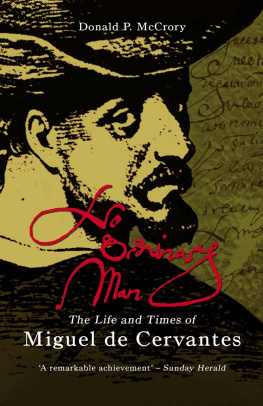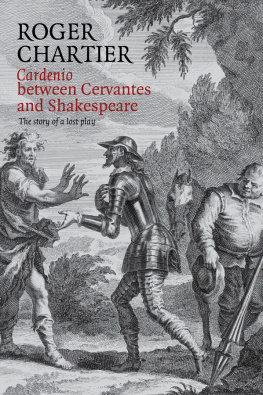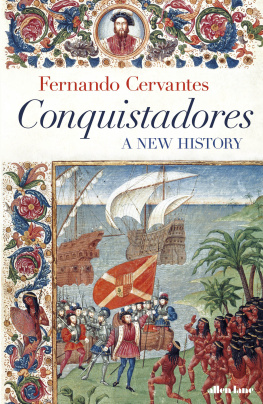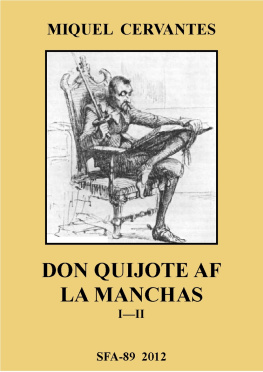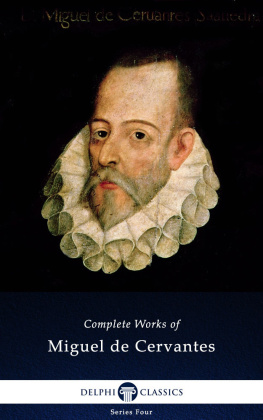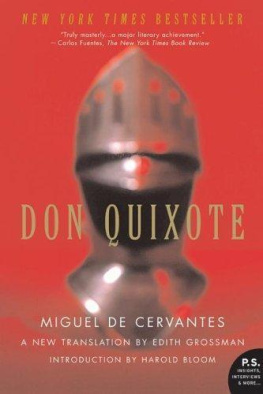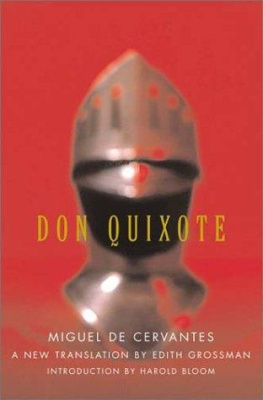PRAISE FOR
NO ORDINARY MAN
McCrory has painstakingly assembled unadorned facts and sifted the scholarship on the context of his subjects life efficiently, painlessly and usefully he is mercifully free of literary theory and is more interested in constructing an honest life and times rather than making inferences about the man from his work. Felipe Fernandez-Armesto, Literary Review
McCrory wisely stays aloof from wild speculations and sticks faithfully to the facts, but the results are no less fascinating the book sheds plenty of new light on one of the most fertile and prodigious minds of the Renaissance. Fernando Cervantes, Tablet
Cervantes created a character who, in being of a time and a culture, transcends both. It was and remains a remarkable achievement. So is McCrorys. Stripping a story of myth restores a touch of humanity to a man whose legacy is little less than our understanding of the power of human sympathy and the powers of imagination. Sunday Herald
Donald McCrory narrates the action-packed years of Cervantes life how could you go wrong with such a story? The biography is brilliantly timed. Sunday Times
Impressive research McCrory understands where his predecessors ventured and offers a strightforward view of Cervantes life, with informed conjectures regarding the gaps and with attention to historical and literary context A fascinating story. Choice (USA)
McCrorys biography has advantages that make it worthy of our attention He who reads this biography will learn a lot about the Spain of Philip II and III In his reading of [Spanish] documents McCrory reveals to us many details we had not considered. Daniel Eisenberg, Cervantes Society of America
NO ORDINARY MAN
The first biography to be aimed at the general reader as much as at students and historians, No Ordinary Man is a fascinating study of the life and work of Miguel de Cervantes (15471616), the writer known as the Spanish Shakespeare and author of the timeless classic Don Quixote.
A Renaissance man in every sense, Cervantes was, in his time, an adventurer, spy, soldier, hostage and creator of the first European novel. This study is based on the latest original research and incorporates previously unpublished material on Cervantes long period of captivity in Algiers, his involvement in piracy in the Mediterranean, espionage and the Spanish Armada, as well as his work for the Spanish government. Containing much information only previously available in Spanish, No Ordinary Man makes an important contribution to the understanding of this unique literary and historical figure.
DONALD McCRORY is former Principal Lecturer and Head of Hispanic Studies at the American International University in London. He has contributed to many academic journals and published a number of volumes volumes of poetry.
ACKNOWLEDGEMENTS
It goes without saying that this present contribution to biographical studies of Cervantes owes much to others. Research into the Golden Age of Spain is of such a quality today that new material about life under Philip II and Philip III comes to light continually. The same may be said of the life and works of Cervantes. His ancestry, parents, birthplace, friendships and career, as well as his literary production, are constantly under scrutiny; so much so that my aim here is to bring to the general public an accurate account of what is known at present and to offer some account of his writing in relation to his life. In so doing I have had recourse to the remarkable works of others: urban and social historians, court chroniclers, geographers, envoys and ambassadors, travellers, as well as literary analysts.
I should like to express my sincerest thanks to Krzysztof Sliwa, who has unstintingly given his time to reading this text and offering invaluable advice throughout all its stages; to I.A.A.Thompson who advised me on historical matters; to Antonio Feros, whose groundbreaking work on the Duke of Lerma caused me to revise views no longer valid; to Paul Lewis-Smith and Eduardo Urbina, whose helpful comments have eradicated many an error; and to all those cervantistas and Hispanistas whose works have made this book possible. The notes to each chapter could easily have been trebled and signal my debt both to persons and sources. Many of those who helped me along the path are sadly no longer with us, but I remember their encouragement and enthusiasm. Lastly, I would like to express my deepest gratitude to the editorial team at Peter Owen and to my former employer, the American International University in London, in particular to Richard Resch, the Academic Provost, who kindly granted me study-leave to work on this text, and to Martin Winter, Head of Reprographics at the University, who patiently assisted in the assembly of the several drafts that led to the final copy.
Needless to say, any errors found in the text, historical or interpretative, are mine and mine alone.
Donald P. McCrory
CONTENTS
ILLUSTRATIONS
Miguel de Cervantes as young man
Alcal de Henares
Map of Europe in the late sixteenth century
Map of Spain under Philip II
Map of the Andalusia of Cervantes
Philip II as a young man
Sultan Suleiman I
The Duke of Alba
The Princess of Eboli
The four wives of Philip II
Philip II and Elizabeth of Valois
Don John of Austria
Don Carlos
Don John of Austria
Ali Pasha
Tapestry depicting the conquests of Tunis and La Goletta
Algiers in the mid sixteenth century
Fray Juan Gil ransoming Cervantes
Cervantes signature on the Informacin II
A Spanish galleon
Sir Francis Drake
Charles Howard of Effingham, 1st Earl of Nottingham
El Escorial
Watercolours of a male and a female Moor
Cervantes as a barquero
Philip II in old age
Philip III
The Duke of Lerma on horseback
Philip III on horseback
Lope de Vega
INTRODUCTION
In the study of Cervantes the dispersion of error is the first step in the discovery of truth. As regards biographies of Cervantes I have mainly used as sources those written after Astrana Marns monumental study of 194758. For those interested in earlier biographies, the as yet unpublished doctoral thesis of Krzysztof Sliwa of Indiana University, La Historia de las Biografas de Cervantes (1997), is the best on the subject and highly recommended. In it Dr Sliwa examines nine major biographies including those of Astrana Marn and Jean Canavaggio and points equally to their contributions and failings. It is true to say that many of his findings lend support to the view that there has been too much of conjecture and fantasy and too little valid documentary evidence. His invaluable research also supports the method adopted in this work of mine.
Although Astrana Marns text contains much that is not relevant to the needs and tastes of the modern reader, his discovery and use of one thousand hitherto unpublished documents overshadows all previous works. A modern classic, with warts and all, his seven-volume study, which took twenty years of unceasing labour to complete, is a major contribution. No modern biography of note has been written without reference to it. But even his work is now over half a century old and relies on work carried out two decades before publication, and a great deal has been researched and published since then that needs to be considered. Scholarly work, in Europe but more significantly in America, has helped to clarify a number of the riddles surrounding the still enigmatic Miguel de Cervantes.
It may be surprising to learn that the first biography of Cervantes was commissioned not by a Spaniard but by an English aristocrat, Lord Carteret, who asked Mayns y Siscar to write a full-length study worthy of the subject. And so it was that in 1738 the
Next page
